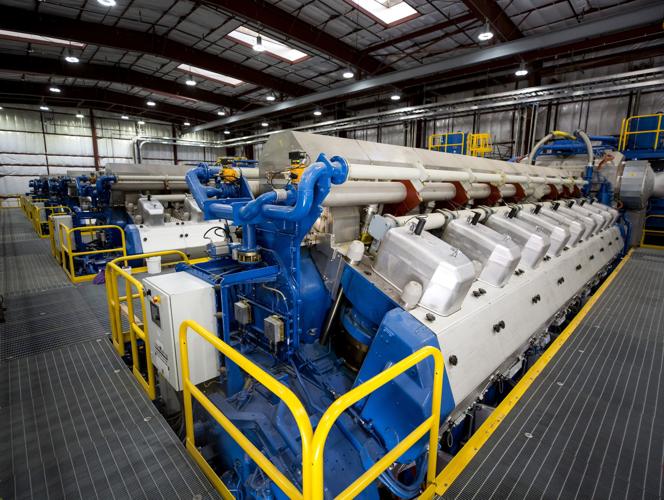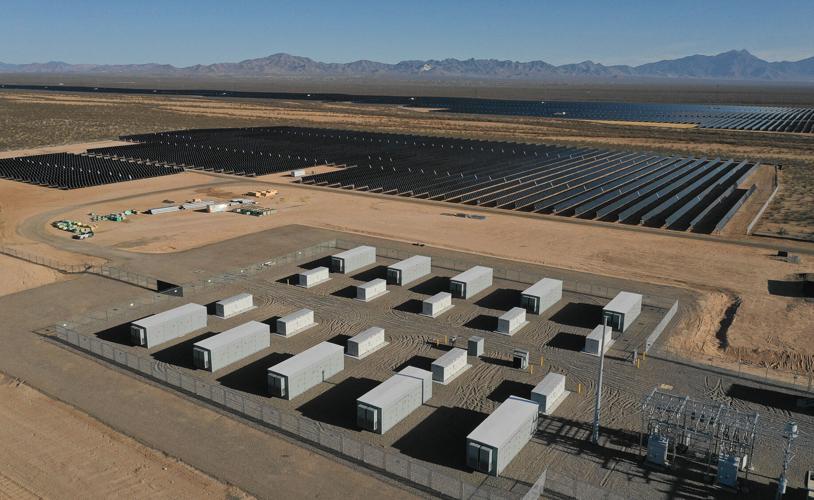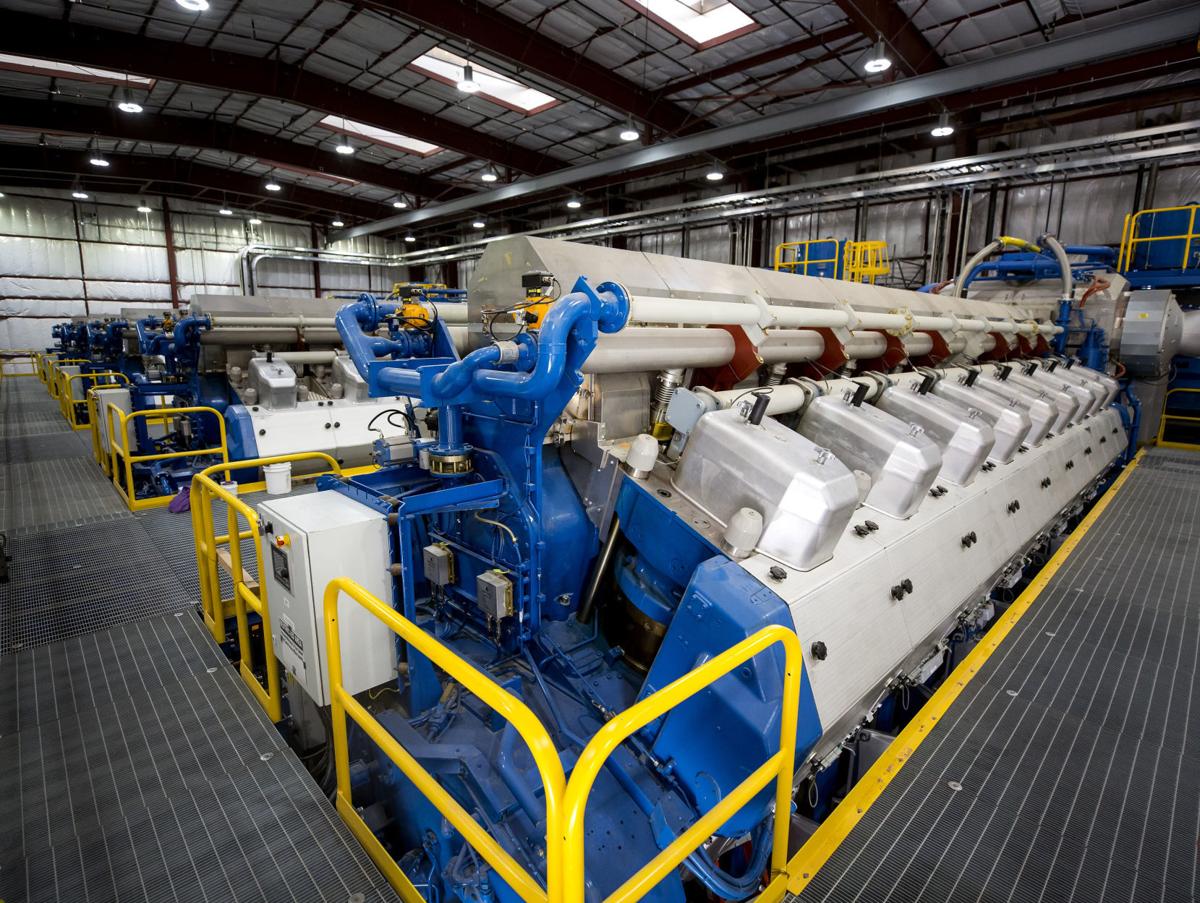Tucson Electric Power has out put its biggest call for renewable energy yet as part of long-term resource plans to cut its climate-warming carbon dioxide output by 80% by 2035, as it retires coal plants that have powered Arizona for decades.
But TEP’s latest plan also would add a significant amount of generation from burning natural gas, drawing criticism from environmental groups that want the utility to swap more gas generation with energy storage and measures to conserve power and reduce peak power demand.
What TEP eventually builds or buys will have a long-term impact on utility customers’ pocketbooks, as well as the air they breathe and the global climate.
TEP and its sister rural utility, UniSource Energy Services, recently opened bids for new energy resources to follow through on plans each utility filed with state regulators in November.
TEP’s integrated resource plan describes how the company will accelerate its clean energy expansion with the addition of 2,240 megawatts of wind and solar generation and 1,330 MW of energy storage by 2038, as well as 400 MW of natural gas turbines to help offset coal plant retirements and support higher use of variable wind and solar energy.
Putting out the call
In early January, TEP and UniSource announced a joint request for proposals, or RFP, for new resources including up to 625MW of renewable energy generation such as wind and solar, and energy efficiency and demand-management programs that can be in operation no later than May 2027.
The utilities also are seeking up to 825MW of “firm capacity” resources that can be called on at any time, including energy storage systems designed to provide at least four hours of continuous energy every day during the summer to dispatch as needed, and also potentially including demand-response programs.
And for UniSource, which provides power to about 100,000 customers in Santa Cruz and Mohave counties, the latest resource plan would add significant new company-owned or contracted generating resources, to reduce the utility’s current 40% reliance on wholesale power purchases amid tightening supplies across the West.
The latest call for bids follows an initial all-source RFP in 2022 that led to a contract to build TEP’s biggest storage project yet, Roadrunner Reserve.
Now under construction southeast of Tucson, the lithium-iron phosphate battery system will have a storage capacity of 800 megawatt-hours of energy or enough to power about 42,000 homes for four hours.
The initial RFP also resulted in an agreement to purchase the output from Babacomari Solar North, a 160-MW solar facility about 3 miles east of Fort Huachuca in Cochise County that is expected to be in service by the fall of 2025.

A 30-megawatt battery storage facility can be seen with solar panels in the background at Tucson Electric Power's Wilmot Energy Center on South Swan Road.
Balancing considerations
The utilities could also add more natural-gas generation under the “all sources” requests for bids.
TEP says more natural gas is needed to help offset coal plant retirements and support higher use of variable wind and solar energy, which are unavailable when the wind doesn’t blow and the sun doesn’t shine.
“Those new resources will help offset coal plant retirements and support greater use of variable wind and solar energy,” TEP spokesman Joe Barrios said. “With each all-source request for proposal, we’ll need to consider several questions throughout the process. How much will a new resource cost? What kind of impact might it have on customer bills? How will it support reliability, and how soon can it start providing service to customers? We need to balance a number of considerations.”
Barrios said the contribution of solar or wind resources, as well as storage, to satisfying peak energy demand diminishes as more is added.
“As we add additional renewables, the specific need for dispatchable resources will change over time as our resource mix and customer energy needs change,” Barrios said.
Based on the resources TEP has in place today, Barrios said, for each additional megawatt of solar the utility adds, only about 30% of its capacity will contribute to satisfying peak energy needs, or put another way, in terms of satisfying peak energy needs, about 3MW of solar capacity is equivalent to about 1MW megawatt of dispatchable generation like a natural gas resource.
Praise and criticism
Environmental advocates have praised TEP for its move to renewables and carbon-free goals.
And in a Sierra Club ranking of major utilities nationwide based on their plans to shed coal generation and add renewables and gas plants, TEP is in the middle of the pack and has rated higher than APS or the self-regulated Salt River Project.
But a Sierra Club leader said TEP’s most recent resource plan represents a step backward for the Tucson utility.
Sandy Bahr, director of the Sierra Club Grand Canyon Chapter, said the group was pleased when TEP’s 2020 integrated resource plan didn’t include plans to add any added natural gas and the utility moved up some dates for coal-plant retirements.
“Fast forward three years, and they’re proposing to add quite a lot of gas, and we think that they can meet their needs without it,” Bahr said. “We have done modeling, we have pointed to other utilities, we have pointed to what TEP itself has said, so it is disappointing.”
Calling climate change “an existential threat,” Bahr said TEP and other utilities can do more to halt its advance.
“I think TEP can do better for people in Tucson, where they’ve supported strong climate action plan at the city and (made) a declaration of a climate emergency, and I think have repeatedly shared with TEP that they want to see the utility take a cleaner path, faster,” she said.
Bahr, who was part of a TEP stakeholder advisory council on resource planning, said she was also hoping TEP in its latest resource plan would further accelerate coal-plant retirements.
As part of its 2020 resource plan, TEP commissioned 480MW of new wind and solar plus storage projects in 2021 and 2022, retired 170MW of coal capacity at the San Juan Generating Station in June 2022 and transitioned to seasonal operations at the Springerville Generating Station in 2023.
Coal closures
TEP’s preferred plan keeps the Springerville Unit 1 coal plant in east-central Arizona in operation until the fall of 2027, with a unit at the Four Corners plant in New Mexico retiring in 2031 and Springerville Unit 2 shutting down in 2032.
Since 2012, TEP has reduced the share of power it gets from coal from 83% to 29% in 2020, while upping the portion of power it gets from natural gas from about 7% to 40%.
Alex Routhier, a senior policy advisor at the environmental group Western Resource Advocates who also served on TEP’s resource planning advisory group, said his organization is pleased overall with TEP’s efforts toward clean energy.
“We’re really happy with their decarbonization efforts, and I think they are showing that a utility in Arizona, when they put their mind to it, can decarbonize,” he said.
But Routhier said he was surprised by TEP’s inclusion of new gas generation in its latest plan and isn’t sure how the utility decided it was needed.
TEP has shared its computer models with stakeholders including WRA but hasn’t shared how it arrived at what the company calls a “hand crafted” resource plan, he said.
“We like the decarbonization, we think they’re moving in the right direction — we just want them to show us their work,” Routhier said, adding that some studies show utilities could get up to 90% of their power from renewables.
Though gas power plants typically emit about half of the climate-warming carbon dioxide emitted by coal-fired plants, they also put out nitrous oxides and produce ozone that can cause respiratory problems.
More worrying to climate scientists, natural gas production can result in leaks of methane, which is 28 times more potent as carbon dioxide at trapping heat in the atmosphere, according to the U.S. Environmental Protection Agency.
Natural gas costs hit
Critics of natural gas also cite the volatile nature of gas prices, pointing to a spike in mid-2022 that sent prices to about $9 per million British thermal units(Btus), after fluctuating in the range of about $2 to $5 for most of the previous decade.
Customers of TEP and APS are now paying back the utilities for excess gas costs from the price spike, through higher pass-through surcharges on their bills.
But TEP in its resource plan cites a price forecast for natural gas from the Permian Basin in New Mexico and West Texas that shows prices rising from less than $3 per million Btus to around $4 by 2028 and then flattening thereafter.
State regulators have had misgivings about adding more natural-gas generation in the past.
In 2018, the Republican-controlled Arizona Corporation Commission slapped a temporary moratorium on construction of new gas plants and declined to accept resource plans filed by TEP and APS, citing cost concerns and the lack of alternatives in the utilities’ plans.
TEP retired two gas-fired steam generators at its H. Wilson Sundt Generating Station on Tucson’s south side in 2020 but added a bank of more efficient gas-burning reciprocating internal combustion engines at the plant.
The Sundt gas generators, along with the joint purchase by TEP and UniSource of a 550MW gas-fired unit at the Gila River Power Station in 2018, avoided the state gas moratorium.
While adding some gas, the utility plans to retire one of two remaining gas-fired steam units at Sundt in 2032, but the other is planned to remain for at least the next 15 years, says TEP, which stopped burning coal at the local plant in 2015.
TEP’s carbon-reduction goals — which include reaching “net zero” greenhouse gas emissions by 2050 — far surpass requirements set by the Arizona Corporation Commission, which after years of debate in 2022 rejected proposed new state clean-energy rules that would have required state-regulated utilities to reach 100% carbon-free energy generation by 2070.
As a result, the state is left with a renewable-energy standard adopted in 2006 that requires that regulated electric utilities source 15% of the electricity from renewable resources by 2025.
TEP and Arizona Public Service Co., the state’s largest utility, have already blown past those requirements, and their longer-term goals surpass the rejected clean-energy rules.
Unlike the Corporation Commission in 2019, the current commission doesn’t seem too concerned about excess natural-gas generation.
Bahr noted that the commission last November approved a major expansion of APS’ Sundance gas plant near Coolidge, without holding hearings or allowing public comment.
Energy efficiency
TEP’s resource plan also calls for increasing its demand-side management programs, which includes energy-efficiency programs offering customers rebates for upgrading things like heating and cooling units and pool pumps, and so-called “demand response” programs which allow the utility to cut participating customers’ power usage to help manage periods of peak demand.
TEP’s latest demand-side management plan, approved by the Arizona Corporation Commission last August, has a three-year energy savings goal of 4.2% of annual retail power sales.
TEP says it has enrolled more than 7,000 residential customers in its Smart Rewards demand-response program, which allows the utility to control participating customers’ smart thermostats to reduce load during summer peak hours, in exchange for cash rebates of $90 per thermostat each cooling season.
TEP says it expects to enroll up to 24,000 thermostats in the voluntary program by 2026.
Caryn Potter, Arizona representative for the Southwest Energy Efficiency Project, said the energy-efficiency advocacy group is still studying TEP’s resource plan but it seems encouraging.
“We’re really pleased to see the company starting to show the true value of energy efficiency and demand-response systems have on the system, and allowing it to come through not just as separate customer programs, but to have them recognize that these are resources that show up for reliability purposes in a really significant way,” Potter said.
What’s next
The utilities’ integrated resource plans will be considered over the coming months at the Arizona Corporation Commission.
Formal comments from stakeholders are due to be filed Jan. 31, followed by company responses by May 31.
The ACC’s utilities staff is expected to issue an assessment and a proposed order by the end of August, and the matter is expected to go before the full commission in the fall.
Check out some innovative and sometimes overlooked energy-saving strategies that can help you and your wallet survive Tucson's summer swelter.






